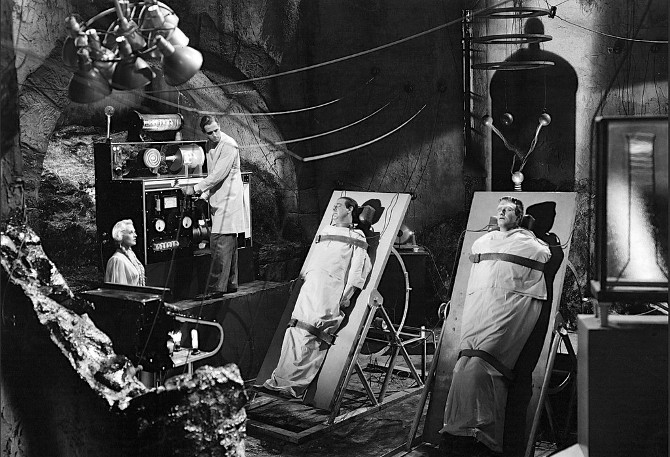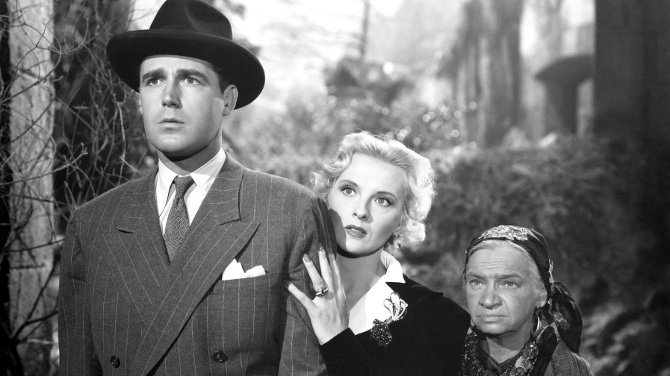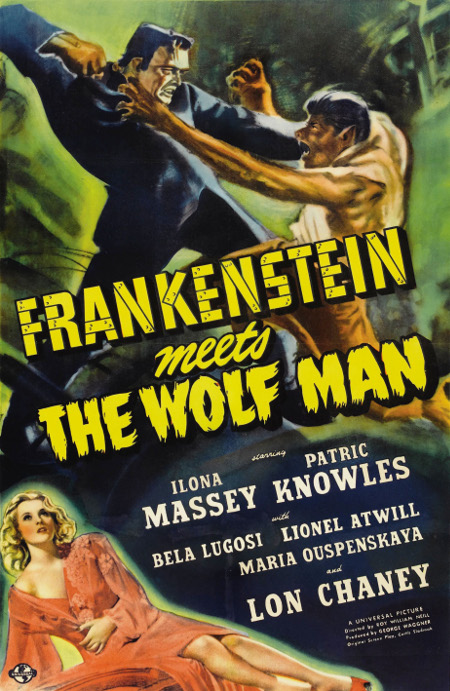The first of the Universal monster movie crossovers (which is celebrating its 75th anniversary this 2018), 1943’s Frankenstein Meets the Wolf Man comes as the fourth sequel in the bolt-necked monster franchise, and a direct sequel to the tortured Lawrence Talbot feature, a man who was bitten by a werewolf and is now himself inflicted.
Written by The Wolf Man scribe Curt Siodmak (and directed by Roy William Neill – a frequent 1940’s Sherlock Holmes director), the screenwriter continues his tale of the tormented Talbot (Lon Chaney Jr. reprising his role) – cursed with the pentagram, the mark means that he is forever a pursued man (symbolic of the Star of David during World War 2, Siodmak, a German Jewish man, wrote the Wolf Man as a conduit for the horrid tale of his peoples’ torture, pain and death), a man who has supposedly been dead for four years.
With some thieving individuals having heard the rumour that the man was buried with his extremely valuable gold ring, money and other desirable trinkets, the pair soon discover that his corpse, which is covered with wolf’s bane, has not decomposed. . . the light of the full moon awakening the monster inside – death cannot easily strike down a curse such as this.
Waking in a hospital after receiving a bump on the head, Talbot immediately remembers his plight, something Inspector Owen (Dennis Hoey) and Dr. Frank Mannering (Patric Knowles) do not believe in the slightest. Proposing that Talbot is insane, their lack of belief allows the man to escape that night (his transformation from Talbot into the Wolf Man a brilliant touch – a shot of the full moon cuts to the barred hospital window, the light slowly seeping through as it creeps along the floor until it hits the face of the bedridden man – special cinematography from George Robinson). Immediately contorted (a Chaney Jr. specialty), the beast ends up murdering a beat cop.
Obsessed with finding a way to end his life – the only way he believes he can eradicate the curse, he returns to the sole person he knows that has some knowledge of the pentagram, the gypsy Maleva (Maria Ouspenskaya – also reprising her role). . . who knows that it is her destiny to help.
With only one possible solution, she directs the tortured soul to the castle of one Dr. Frankenstein – learning upon their arrival that it has been mostly destroyed in a major fire. While investigating the remnants (looking for the Dr.’s scientific journal), Talbot discovers the monster (Bela Lugosi) frozen in ice. Weak but alive (loosely speaking), Talbot is able to curb his anger. . . leaving him at the castle while he tries to learn whether Frankenstein’s daughter, Baroness Elsa (Ilona Massey), knows the location of the elusive journal. Has Talbot made a mistake waking the trapped monster? Will Dr. Mannering, the monster, or Maleva be able to help Talbot? Will Frankenstein’s gothic style castle bring a change to their scientifically organized minds?
A fun, if anticlimactic, crossover, many changes were made to the screenplay. . . originally, Lugosi’s Monster was able to talk and was blind due to Ygor’s brain having been placed in his head at the end of The Ghost of Frankenstein (both edited out of the final product, it helps explain why the Monster is constantly lumbering around with arms outstretched, truly ridiculous and never close to causing much terror – this helped perpetrate the Frankenstein-style walk stereotype). Also, Chaney Jr. was supposed to play both creatures, though makeup constraints forced the change. . . meaning Lugosi was brought in – though he was only on screen for five minutes and six seconds (stunt doubles taking care of the more strenuous scenes for the sixty year old).
Neill, using Siodmak’s script, builds a creepy atmosphere (Robinson’s use of shadow and light further strengthening the look of the realistic sets), the director selecting excellent camera positions, and when paired with quality editing, makes for a fast paced one hour, fourteen minute motion picture that’s only real flaw is that it could have used a few more minutes of action to bolster the climax. It is also wonderfully cast – each actor, be it a larger or smaller part, having a realistic feel – it is also worth noting a small performance from Dwight Frye (Renfield and Fritz in the original Dracula and Frankenstein pictures), it is nice to see the man in his last credited role – sadly dying that year of a heart attack at the young age of 44); while the great Lionel Atwill does a solid job as the small town mayor who puts his hopes and prayers in the hands of the rag tag team who plan to eradicate the Frankenstein monster. So, see this clash of the titans, it is a dam good time.




